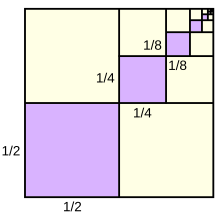
Back የጂኦሜትሪክ ዝርዝር Amharic متسلسلة هندسية Arabic গুণোত্তর ধারা Bengali/Bangla Geometrijski red BS Sèrie geomètrica Catalan زنجیرەی ئەندازەیی CKB Geometrische Reihe German Serie geométrica Spanish سری هندسی Persian Série géométrique French
This article needs additional citations for verification. (August 2024) |


In mathematics, a geometric series is a series in which the ratio of successive adjacent terms is constant. In other words, the sum of consecutive terms of a geometric sequence forms a geometric series. The name indicates that each term is the geometric mean of its two neighbouring terms, similar to how the name arithmetic series indicates each term is the arithmetic mean of its two neighbouring terms.
In general, a geometric series is written as , where is the coefficient of each term and is the common ratio between adjacent terms. For example, the series
is geometric, because each successive term can be obtained by multiplying the previous term by .
Geometric series have been studied in mathematics from at least the time of Euclid and Archimedes, who evaluated and proved the sum of a geometric series using geometric methods, and had an important role in the early development of calculus. They serve as an introduction to frequently used mathematical tools such as the Taylor series, the Fourier series, and the matrix exponential.
© MMXXIII Rich X Search. We shall prevail. All rights reserved. Rich X Search




